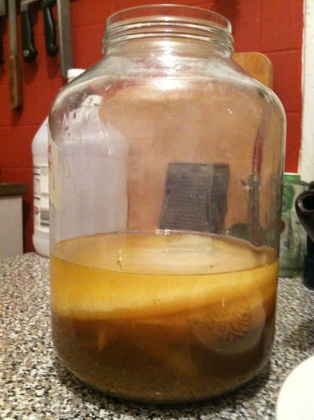JUN
- Get a glass jar that holds ¾ gallons to 1 gallon of water or 1.5-5liters.
- Brew the tea. Pour hot filtered water over 4-5 green tea bags or the equivalent of loose tea. Organic is better because anything added to the tea leaves to kill pests can also kill your culture. Add 1c honey and mix well. Only use honey. I use raw honey.....That’s what the jun culture is adapted to. Let the sweetened tea sit until the temperature is comfortable to the touch—usually I let it sit overnight. If it’s too hot, you’ll cook your mother: she is alive!
- Strain out the tea leaves.
- Put your SCOBY mother (Symbiotic Colony of Bacteria and Yeast) on the top of the culture. She might float down to the middle of the jar. That’s okay. Add ¼ to ½ cups (I just throw in a good sized “glurp”) of starter jun liquid, from your last batch. You can add even more if you want. Using starter liquid from your last batch helps create a pH environment that is inhospitable to molds, so if you have had mold trouble with other ferments, you might want to use more starter.
- Cover it securely with a towel. You want it to be able to breathe, but you also don’t want bugs to get in. I suggest securing it with a couple of rubber bands.
- Leave it in an out-of-way place, out of direct sunlight for 1-3 weeks. After 1 week, taste it. If it’s too sweet for your liking, then it’s not done. Put it back and let it keep going. If it’s too sour, you let it go too long. It’s still okay, just not as pleasant. Batches will ferment faster in warmer temperatures.
- When the batch is done, you will notice that a new SCOBY has formed at the top of your jun liquid. Now you have two mothers. You can save one as a back up, give it away, compost it, or look for other options: if you look online, you’ll find people who have developed recipes for SCOBY (eeeeww). I’ve also heard of people drying them and turning them into fabric.
- You can leave your finished jun in a big jar, or you can bottle it. Bottling the jun will help it to build up more bubbles, because you are not constantly opening and closing the same container and the pressure can build a little. If you are bottling, this is also a good time to flavor it. A few pieces of chopped ginger will make an extra fizzy one, or you can add other herbs. I like to use a few dollups of frozen juice concentrate (my favorite lately is pineapple). Edible aloe vera can make an interesting addition to your jun cocktail as well.
- Once you have bottled your Jun, you may leave it out for about a day, especially if you have flavored it, to create a secondary ferment which will let the flavors sink in and build up bubbles. Soon, you will want to put it in the fridge, to slow down the fermentation process, or you’ll end up with a super sour and potentially explosive brew.
- Make another batch! If you wait in between, you can store your SCOBY in a little bit of jun liquid, sealed in a jar in the refrigerator. She will lie dormant until you are ready to rock. You can also store her at room temperature in a little liquid, with a towel covering the container. This is what has been referred to by fellow fermenters as a “SCOBY hotel.” If you leave her at room temp, she will continue to grow, so you should check periodically to make sure that there is still liquid in your hotel.
Tips and FAQs:
1. It’s a pretty no-fail recipe, but sometimes things can happen. If you see mold growing on your mother THROW IT OUT! If flies invade, throw it out. But, if there are little brown strands hanging off the bottom of your mother, or if the mother has air bubbles in her, it’s okay.
2. Jun, like kombucha and tibicos, will corrode metal. If you handle your Jun brew or SCOBY intermittently with metal implements such as a fork, or a metal strainer, that’s okay. You do not want it in prolonged contact with metal, or you will both contaminate your SCOBY mother and ruin your metal. You probably don’t want it in prolonged contact with plastic either. I can just imagine what creepy chemicals that would leach out.
3. What does it taste like? My Jun has a ‘lighter’ taste than kombucha, perhaps more astringent. If you let it go too long, I think it gets even more vinegary than kombucha.
4. What’s the difference between kombucha and Jun? Kombucha is a culture adapted to fermenting tea and sugar, whereas Jun takes green tea and honey. That’s the big difference. I’m sure a bioscientist could tell you more specifics about the organisms in there. I have found that my Jun tolerates cooler brewing temperatures better than kombucha in the winter, and it will grow a thicker SCOBY more rapidly. Jun also tends to develop more sediment than Kombucha at the bottom of the bottle. This is the lees, in brewers terms. Lees forms in wines also. You can drink the sediment or filter it out.

The batch after I bottled most of it. Notice the cloudiness at the bottom of the bottle, from the sediment.

.JPG)
No comments:
Post a Comment